What is ChIP-Seq and Is It Quantitative After All?
ChIP-seq (pronounced chip-seek, short for chromatin immunoprecipitation sequencing) is a tool for analyzing the interactions between DNA and the proteins that bind to it, like transcription factors (TFs) and histone post-translational modifications (PTMs), which are known to significantly influence gene expression. ChIP-Seq involves freezing DNA-protein interactions in place, and then using antibodies to precipitate these complexes of DNA and protein. Antibodies that are directed against specific TFs or PTMs are used to probe these complexes for those of interest. The protein-bound regions of DNA are then sequenced and aligned to the genome. This produces a map of targets where some specific TF or PTM binds.
The ChIP-seq tool provides a lot of information about regions of DNA that bind certain proteins. A drawback, however, was that it was not thought to provide any quantitative data. New research has suggested, however, that ChIP-Seq may have been a quantitative measuring tool all along. The findings have been reported in the Journal of Biological Chemistry.
"ChIP-seq is the backbone of epigenetics research. Our findings challenge the belief that additional steps are required to make it quantitative," said the corresponding study author Brad Dickson, Ph.D., a staff scientist at Van Andel Institute. "Our new approach provides a way to quantify results, thereby making ChIP-seq more precise while leaving standard protocols untouched."
There have been attempts to find ways to normalize ChIP-seq results so they can be compared, such as by using additive called spike-ins, which are thought to reveal any obscured changes in histones. However, they can also introduce another variable to an experiment, which may lead to irreproducibility.
This work utilized what's called the 'sans-spike-in method for Quantitative ChIP-sequencing,' or siQ-ChIP. It eliminated spike-ins from the protocol, and highlights some standard measurements from ChIP-seq experiments that can be used for quantification, and promote reproducibility.
The researchers investigated whether these antibody-chromatin interactions represent binding reactions that are at equilibrium, and found that these reactions do reach a state of equilibrium; the binding isotherm of the IP products can be used as a physical scale to compare experiments. If the antibody levels, chromatin concentration, and immunoprecipitation volumes are equal, the authors stated that "ChIP-seq results can be quantified and compared by relationship to the isotherm."
Sources: AAAS/Eurekalert! via Van Andel Research Institute, Journal of Biological Chemistry


![Master Lab Weighing: Accuracy, Compliance & Audits [eBook]](https://d3bkbkx82g74b8.cloudfront.net/eyJidWNrZXQiOiJsYWJyb290cy1pbWFnZXMiLCJrZXkiOiJjb250ZW50X2FydGljbGVfcHJvZmlsZV9pbWFnZV85MWRmZmRjMDIwNDBlMWJjMzYwN2ZiYWY2ZjI4ZGMzYzBmZGMwZGMyXzkxOTcucG5nIiwiZWRpdHMiOnsidG9Gb3JtYXQiOiJqcGciLCJyZXNpemUiOnsid2lkdGgiOjcwMCwiaGVpZ2h0IjozNTAsImZpdCI6ImNvdmVyIiwicG9zaXRpb24iOiJjZW50ZXIiLCJiYWNrZ3JvdW5kIjoiI2ZmZiJ9LCJmbGF0dGVuIjp7ImJhY2tncm91bmQiOiIjZmZmIn19fQ==)






